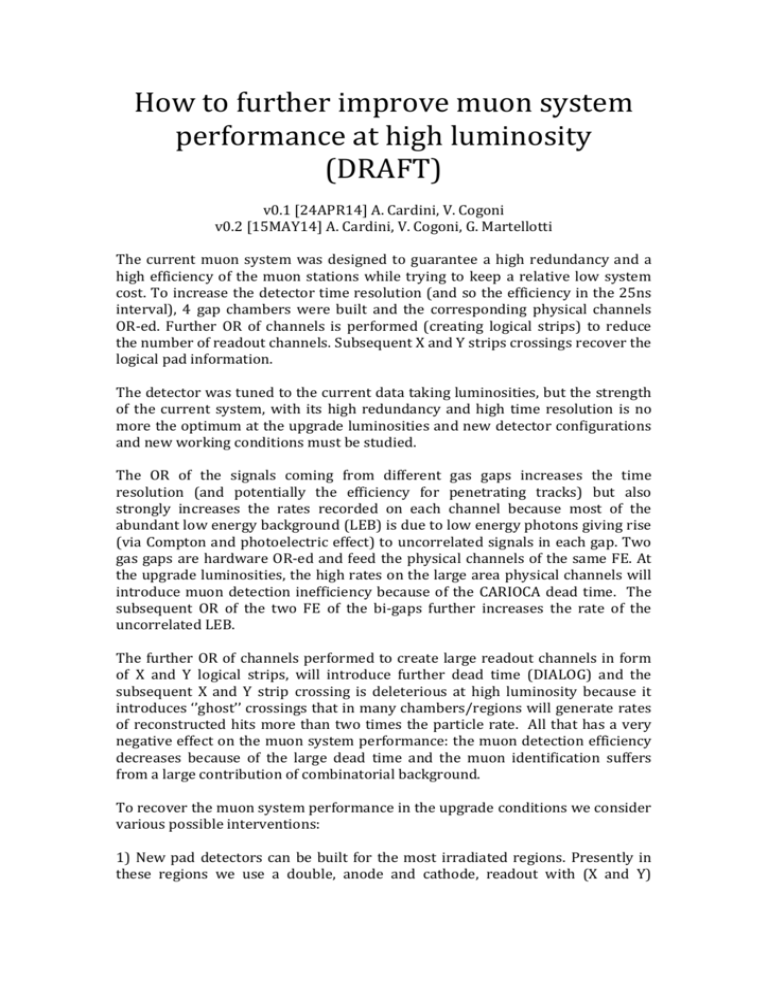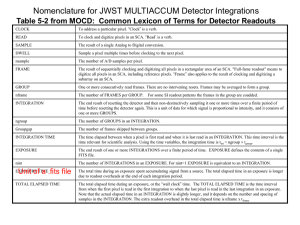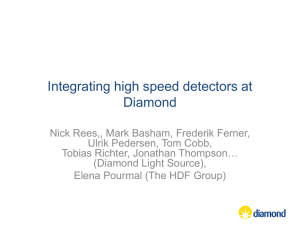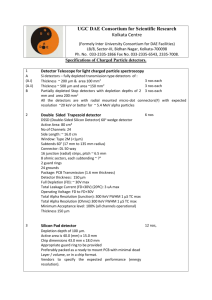draft
advertisement

How to further improve muon system performance at high luminosity (DRAFT) v0.1 [24APR14] A. Cardini, V. Cogoni v0.2 [15MAY14] A. Cardini, V. Cogoni, G. Martellotti The current muon system was designed to guarantee a high redundancy and a high efficiency of the muon stations while trying to keep a relative low system cost. To increase the detector time resolution (and so the efficiency in the 25ns interval), 4 gap chambers were built and the corresponding physical channels OR-ed. Further OR of channels is performed (creating logical strips) to reduce the number of readout channels. Subsequent X and Y strips crossings recover the logical pad information. The detector was tuned to the current data taking luminosities, but the strength of the current system, with its high redundancy and high time resolution is no more the optimum at the upgrade luminosities and new detector configurations and new working conditions must be studied. The OR of the signals coming from different gas gaps increases the time resolution (and potentially the efficiency for penetrating tracks) but also strongly increases the rates recorded on each channel because most of the abundant low energy background (LEB) is due to low energy photons giving rise (via Compton and photoelectric effect) to uncorrelated signals in each gap. Two gas gaps are hardware OR-ed and feed the physical channels of the same FE. At the upgrade luminosities, the high rates on the large area physical channels will introduce muon detection inefficiency because of the CARIOCA dead time. The subsequent OR of the two FE of the bi-gaps further increases the rate of the uncorrelated LEB. The further OR of channels performed to create large readout channels in form of X and Y logical strips, will introduce further dead time (DIALOG) and the subsequent X and Y strip crossing is deleterious at high luminosity because it introduces ‘’ghost’’ crossings that in many chambers/regions will generate rates of reconstructed hits more than two times the particle rate. All that has a very negative effect on the muon system performance: the muon detection efficiency decreases because of the large dead time and the muon identification suffers from a large contribution of combinatorial background. To recover the muon system performance in the upgrade conditions we consider various possible interventions: 1) New pad detectors can be built for the most irradiated regions. Presently in these regions we use a double, anode and cathode, readout with (X and Y) physical channels much larger than the logical pads obtained by the AND of X and Y. 2) In the other regions the size of the logical strips of the readout channels can be decreased by reducing the number of logical channels OR-ed to form the X and Y logical strips. 3) In the most critical chambers where the dead time inefficiency is very high or the rate of reconstructed hits is particularly deleterious for an efficient muon identification, the rates can be decreased by reducing the number of active gas gaps (switching off the HV), or making the AND of the two FE at the price of a worsening of the efficiency due to the time resolution. 4) The optimal working point of the chambers should be retuned when working at high luminosity. Solutions 1) and 2) require a non-negligible implementation effort but will guarantee the detector performance for the upgrade conditions. We consider the interventions 3) and 4) as “final/fine system tuning” options, to be implemented if and where required. Table 1: muon system rates in kHz/cm2 at 2E33 (from PID Upgrade TDR). 1. A new pad detector scheme This solution is applicable to the most irradiated regions: M2R1, M2R2 and M3R1, where rates as high as 600, 100 and 200 kHz/cm2 are expected at a luminosity of 2E33 as shown in Table 1. (There are unavoidably large uncertainties in the extrapolations used to produce such table; in addition we should not forget to include the effect of the new shielding behind M5, we will measure the effect when beam will be back.) Increasing the readout density of these central chambers could require the need of a new highly integrated FE chip. Could we afford this solution with such a tight upgrade schedule and the current manpower available? We all agreed that the answer is NO. The reason is not only in the chip that needs to be designed and produced, but also in the fact that to readout such a large number of channels from a detector the only reasonable solution is the readout via optical fiber with an ODE-equivalent on board of the detector, that needs to be designed and produced. (This brings us to also exclude other possible FE chips that could be available on the market.) FE and DIALOG control is also an issue, because one would also need to have SB and PDM functionalities on-board of the detector. Also power considerations are not negligible. The conclusion is that we cannot change the chamber readout philosophy too much, and we should stick to a maximum channel number for an R1 chamber of 192, a feasible solution because it is currently used in M1R1 (although with a customized reduced-size CARDIAC, the CARDIAC-GEM). Reading 192 channel from an R1 (and possibly R2) chamber has a non-negligible impact on infrastructural work: new signal cables must be installed (to be carefully studied!) on the walls and need to be connected to the ODE crates. New power cables (and possibly a few control cables) are also needed. Finally new fibers should be used to send data to additional TELL40s. Detector redesign is now a possibility because the baseline for the low level trigger (LLT) is the fully software implementation, but this readout granularity increase is not possible (or at least extremely difficult) if a TELL40-based LLT is to be implemented. (The design and integration of new chambers for M23R12 should be discussed in detail with the trigger people.) 1.1) M2R1 is currently readout via cathode pads and wire pads, of size respectively 37.5 x 31.3 mm2 and 6.3 x 253 mm2. There are 64 cathode pads and 48 wire pads in M2R1, for a total of 112 readout channels and 384 logical pads obtained by pad crossing. The solution would be to build new detectors with 384 readout pads, of the same size of the actual logical pad size. However we cannot fit on an R1 chamber the FE boards needed (48) to readout 384 channels. So the proposal is to have 192 pads of twice the size of the current logical pad, 12.6 x 31.3 mm2. This will require 4 additional nODEs for the readout of the whole M2R1 region. 1.2) M2R2 also is currently readout via cathode pads (64) and wire pads (48), of size respectively 75 x 31.3 mm2 and 12.5 x 253 mm2. The logical cathode pad is an OR of 4 cathode pads for a final size of 150 x 62.6 mm2. There are 192 logical pads of size 12.5 x 62.6 mm2 on each chamber. Two solutions were considered for the pad detector: i) a pad detector with pads of the same shape of the current logical pads; ii) a pad detector with pads with half the height and double width, for a final size of 25 x 31.3 mm2. The request of having pads with a small X size can be released for the upgrade because LLT will be mainly used only to control the total rate to the HLT and not really as a high-pt muon trigger. 16 additional nODEs will be required to fully readout the 24 detectors of M2R2. (A discussion we had here in Cagliari after the meeting suggested a possible third option with the readout of only 96 pads of size 25 x 62.6 mm2. If rates on each channel are fine from the dead-time point of view, this will simplify the new M2R2 chamber installation because we will not need to install additional cables/nODEs – to be studied. Bepo’s comment: “with this solution the inefficiency due to dead time will likely be at a reasonable level, however the increased pad rates will have a negative effect on the matching of muon hits to a track and by consequence on the muon misID”.) 1.3) M3R1 will sustain between 1/3 and 1/2 of the M2R1 rates and will have similar problems. Here also the proposal is to have 192 pads of twice the size of a current logical pad, 12.6 x 31.3 mm2 (sizes on M2, to be rescaled to M3). 4 additional nODEs will be required for the readout. (A final consideration after the Cagliari discussion: it is also true that if we can withstand the rate of 600 kHz/cm2 on M2R1 on 192 pads while keeping good muon system performance we should probably be also able to sustain the M3R1 rate of 200 kHz/cm2 on pads of twice the area. This would bring down the pads to 96, simplifying the installation because this will not require the installation of new signal cables/nODEs – to be further studied. Bepo’s comment: same as above) 1.4) Detectors technologies. The pad-based detectors described above can be implemented in any technology, however technologies already used in the muon system are preferred because we can better evaluate their overall performance. These technologies are MWPCs and Triple-GEM detectors. An additional solution proposed by Ferrara some time ago was the use of scintillating pads readout by SiPMs. Although this solution could seem very attractive from a detector point of view, there was some concern on the amount of conversions that will take place in the dense scintillator material with the consequent effects on hit rates and dead time (only one channel would be readout instead of two in OR). Other concerns are related to the location of the SiPMs, that need to be far from the detector to be protected from radiation, and this will make the installation of such a detector much more complicated. For what concerns the gas-based technologies, there is an interest from our PNPI colleagues to build MWPC pad detectors for M2R2 and possibly M3R2, although this last region does not seem to be critical. MWPC technology is well known and these detectors could be built without the need of a specific R&D. M2R1 could be more critical for a standard MWPC due to the very high rates. Asymmetric gap MWPCs could be a solution, but some R&D will have to be done for this (and something in that direction was already done many years ago). In our current detector, we decided to use triple-GEMs for M1R1 because rates were expected to be as high as 500 kHz/cm2. Since similar rates are expected for M2R1 in the upgrade conditions, triple-GEM appears to be an adequate technology. Detector construction, using new ideas that have been developed for CMS, is much simplified now. TripleGEM detectors have a slightly worse time response with respect to MWPCs and this translates in slightly lower detector efficiency in the 25 ns time window. However the efficiencies seen in M1R1 (~97-98%) appears to be adequate. The real challenge for the triple-GEM detector option is the needed infrastructural work. We have demonstrated in 2013 that we cannot operate a triple-GEM detector with acceptable performance using the MWPCs gas mixture, so we need to move the GEM gas rack from M1 to M2 and install new gas pipes on the walls. We probably also need to find a more environment friendly gas than CF4, but this is also a CMS problem so eventually a common solution will be found. A different HV will also have to be used for GEM detectors. The current proposal is to use a single channel per gap with a divider on-board of the detector, and this might allow the reuse of the currently existing HV cables. Many details need to be studied. 2. Reducing logical strip size to reduce ghosts Logical strips are created on the CARDIAC and/or on the IB depending on the region/station. There are currently 64 ODEs in M2-M3 and 40 in M4-M5 for a total of 104. In the TDR we have already foreseen the removal of IBs in M5R4, were rates on logical channel are quite high because of the backsplash due to particle coming from the corrector magnet in the tunnel downstream of LHCb. The removal of IBs in M5R4 increases the number of nODE required to readout the whole muon system from 104 to 108. However the removal of IBs in M5R4 does not seem to be enough to guarantee a good performance on the whole muon detector. In particular region M2R3 appears to be critical. In the case of a complete removal of IBs in this region 16 additional nODEs will be required to readout M2R3. According to Bepo the IB removal in M2R3 is more important than in M5R4. The full removal of IBs from the muon system (option D of Paolo’s slides) would require in the worst condition (no crates re-cabling) a total of 216 nODE for the full muon system readout, so an additional 112 nODEs with respect to the current situation. Such a solution will definitely simplify the system layout and will ease the debugging in case of problem, but it is probably not the most cost effective solution. 3. How to reduce particle rates at the source Particle rates on the muon stations are large also because of the presence of the low energy photons converting in the dense material at the edge of each gas gap. The presence of 4 gaps in OR increases the fraction of hits due to conversions, estimated in M2R1 as high as ~90% of the total. A simple and feasible solution is to perform an AND on the CARDIAC instead of an OR. This will practically remove all the background due to photon conversions, but unfortunately it will strongly affect the efficiency because of the reduced time resolution of the AND signal. Furthermore, for geometrical reason, the efficiency will be reduced for muons entering the chamber with large angles with respect to normal incidence. (Rates in OR and AND need to be measured again when beam is back – we should pay attention on the digital signal width programmed in the DIALOG: probably what is optimal for the OR is not optimal for the AND from the point of view of total dead time. In particular, after some inputs from Sandro and Valerio, Alessandro commented that the optimal digital signal width to be used for an AND option would probably be as long as the CARIOCA analog dead time, because in this case the AND could be kept active for the whole analog dead time if one channel fired due to background, allowing however the AND to become true if a real particle was triggering the other channel of the AND within the dead time period – however the DIALOG has probably a maximum width close to 25 ns, so this is likely not possible.) To keep higher efficiency while reducing the number of hits due to conversion it has been proposed by Bepo to switch OFF the two most external gas gaps and operate the detectors in OR but only with two active gaps. Timing efficiency will be slightly reduced (we will be operating as in M1) but could be partially recovered with a slightly HV increase (but with possibly increased detector aging). It is better to work with two gaps belonging to different bi-gaps, because they are readout via independent CARIOCA (and this, while reducing the rate, will also reduce chamber inefficiency due to CARIOCA dead-time) it is better to switch off the outermost gaps to minimize average cluster size, but other less optimal options are possible (this could happen if one gap breaks down and we have to use another one in the OR). When designing a new detector for M23R12 one should also keep in mind the possibility of having a detector without the 1 cm thick foam between the two central gas gaps to allow it to operate in AND, and eliminating the geometrical inefficiencies for large angle tracks. This solution is probably easy to be applied for GEM chambers, where two triple-GEM detector could share a common cathode (approximately 50um thick), so the two sensitive gas gaps will be practically in contact one to the other. 4. Retune the chamber working point at high luminosity The HV and the threshold currently used ensure a very low level of noise and very high muon detection efficiency. However it is very likely that these settings will not be optimal at higher luminosity. The average CARIOCA dead time corresponding to these conditions was measured and resulted to be very high (~80 ns for wire pads and ~90 ns for cathode pads). This large dead time is not important at the present luminosity, but extrapolating to the rates foreseen at the upgrade luminosities, it gives important inefficiencies. A reduction of the average dead time could be obtained operating the chambers at lower HV and in the critical regions the reduction in efficiency due to reduced time resolution could be largely compensated by the reduction of dead time inefficiency. Further investigation and possibly laboratory measurements on the CARIOCA dead time and its dependence on HV would be useful.






